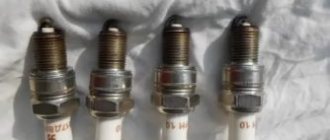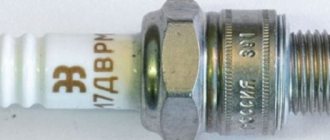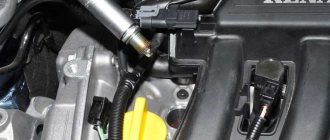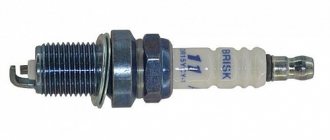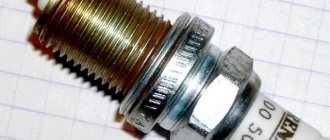Published: 01/28/2021
- When to change spark plugs: main signs
- How often should you change spark plugs?
- Signs of faulty spark plugs
- Signs that it's time to change spark plugs
- Removing dirt from wells
- Prevention
- Selection of spark plugs for replacement
- How to replace or check spark plugs yourself
- Consequences of negligence
- What factors determine the timing of replacement?
- Reasons for their natural and premature wear
- This is necessary and important to know
- How often do you need to change spark plugs?
- Signs and causes of spark plug failure
- 5 How to install new elements - simple instructions
- What are the consequences of untimely replacement of spark plugs?
- How often and when should you change spark plugs?
- Ford Transit glow plug replacement.
- How often should you change spark plugs?
- Signs of engine operation to replace spark plugs
When to change spark plugs: main signs
The fact that replacing the spark plugs is necessary or necessary, at a minimum, to check them, is signaled by the car itself. Symptoms:
- During operation, the engine begins to “touch”. Especially at idle. In addition, there may be a drop in traction and power;
- Increased fuel consumption;
- Increases the amount of carbon monoxide (CO) in the exhaust. The exhaust itself turns black;
- Detonation appears;
- It is difficult to start the engine. The starter may turn, but the engine will not start.
For this reason, if the spark plugs travel less than 10-15 thousand kilometers, then most likely you can only do cleaning and gap adjustment. These procedures are recommended for prevention twice a year: before summer and before winter. Of course, if the annual mileage does not exceed 10-15 thousand kilometers
It is also important to understand that the source of spark plugs is greatly influenced by fuel quality and driving style.
How often should you change spark plugs?
If you are buying a car, you should be prepared to spend a lot of money on it. Oil changes, major and minor breakdowns, insurance... As a result, a decent amount accrues. One of the mandatory procedures that must be carried out in both old and new cars is replacing spark plugs.
Candles perform an important function, since they are responsible for creating a spark. It is this spark that sets the mixture in the engine to work, igniting it. If they are already outdated, the sparks will ignite worse and worse, which is why the engine will not function fully. To be more precise, the car simply won’t start, and you won’t be able to drive it.
How soon can you change spark plugs?
This is an important issue that many people forget about and, as a result, the engine does not start. To avoid unpleasant situations, you need to replace the spark plugs in time; you can do this yourself or with the help of a specialist.
As with oils, the timing of changing spark plugs depends on the age and make of the car, as well as on the roads you drive on.
How do you know when it's time to change spark plugs? It’s not hard to guess - the car won’t start the first time and you’ll have to do it several times. We also advise you to listen to the sounds that the car makes when driving - if it rattles, vibrates and makes uncharacteristic noise, it’s time for you to go to a car repair shop.
Do not delay changing spark plugs, as this will negatively affect engine performance. As a result, it quickly deteriorates and you will have to replace it with a new one, and such a replacement is much more expensive than replacing spark plugs.
The frequency of replacing spark plugs also depends on the quality of fuel you use. If it is not of very high quality, plaque will appear on them much faster. If you notice that you have to change the spark plugs more often, refuel at another gas station with better quality fuel.
The quality of the oil plays an important role. Never use cheap oils, as they cause huge deposits to accumulate on the surface of the spark plugs, causing you to have to change spark plugs much more often.
The older the car, the more often it needs to be replaced. New machines can be used for much longer. Therefore, if your car is not very new, do not forget to regularly inspect the spark plugs for carbon deposits.
You need to choose suitable candles based on the instructions and recommendations from the manufacturer
We advise you to pay attention to their appearance - if they have thick carbon deposits on them, you need to replace the part as quickly as possible
How to extend the life of spark plugs:
- Use only high-quality fuels for refueling
- Change the engine oil regularly with new ones, choose a quality product
- Choose spark plugs in accordance with the recommendations of the car manufacturer
- Remove carbon deposits from candles
- Get your car inspected regularly, so you can prevent many problems and breakdowns.
We advise you to monitor the condition of the spark plugs and change them promptly when plaque appears. If you do not do this, you will have problems starting the car, and the engine may also “fly”. Therefore, it is better to fork out for new candles and not save on their purchase. Good luck!
Men's online magazine Mensweekly.ru
What happens if you tighten the spark plugs on a hot engine and what to do then (personal experience)
Hello dear readers!
I want to tell you my story of how I tightened the spark plugs on a hot engine, not knowing that this should not be done, and how I then unscrewed them when the time came for replacement.
I am the owner of a VAZ 21111 and, like many VAZ owners, I do minor repairs myself.
When the time came for maintenance, including replacing the spark plugs, I came to the garage, unscrewed the old spark plugs, screwed in new ones and didn’t attach any importance to whether the engine was hot or cold; for some reason I thought that it didn’t matter.
A year later, while preparing the car for winter, I decided to change all the consumables again, and I also drove the car into the garage and started unscrewing the spark plugs. But this time I didn’t have the strength to do it. One of the candles is stuck. Having inserted the pipe into the spark plug wrench to create a lever, I tried again, but the wrench broke (it burst at the bend).
I put the spark plug wrench aside and took a ratchet with a spark plug head and, in the hope that now everything would work out, I began to unscrew it. Due to the applied effort, the ratchet clicked (possibly not of good quality), and the ceramic insulation of the spark plug also crumbled. I was afraid that I would break the candle and then my repair would take a long time. I decided to go to the service center. I was in 2 car repair shops and they tried to unscrew everything, but everyone was afraid to use excessive force so as not to take responsibility, they also poured some kind of lubricant into the spark plug well. None of this helped.
Arriving back at the garage, I no longer knew what to do, I thought it would be better if I didn’t touch them at all, and only climbed in when they became “troila”. But the insulation on the spark plug was already all scattered and the spark plug required replacement.
There was a man in our garage who was repairing cars in his garage and I went with him. He also tried to unscrew the spark plug and was surprised that the spark plug was tightened so tightly. He said that you can start the car and let it run so that the engine warms up and it’s easier to turn it off. I replied that I tried this method. He was surprised that this did not help and asked how he tightened the candles? I told it like it is. He then explained to me that the spark plugs need to be tightened only on a cold engine because... the metal in the engine expands when it heats up (of course, not noticeable to the eye) and if you screw the spark plugs into a spark plug at this moment, there is a possibility that it may not be screwed in according to the thread, and also when the engine cools after such screwing, unscrewing the spark plug becomes much more difficult .
He said that he had experienced this in practice and suggested pouring the well-known WD-40 penetrating lubricant into the spark plug well. And leave it overnight. This was the safest way because... if we had broken the candle there would have been much more problems.
We did just that, filled in the grease and left the car in the garage overnight. The next day I came to the garage and saw that the level of liquid in the spark plug well had decreased, which indicated that the liquid had leaked into the cylinder. I took a ratchet with a head and unscrewed the spark plug without much effort. There was no limit to happiness. Below is a photo of the same unscrewed candle.
I removed the remains of the ceramic insulation from the spark plug with a vacuum cleaner; the tube from the vacuum cleaner fit perfectly into the spark plug well.
I will be glad if this information suddenly helps someone.
Thank you for reading the article to the end. like and subscribe to the channel. All the best!
Source
Signs of faulty spark plugs
An experienced driver will always distinguish an old spark plug from one that can still work for a long time. But here's what to do for beginners who are not so well versed in cars. It is for this purpose that we have prepared the main signs of an urgent replacement of spark plugs:
- The engine starts to shake. It is not difficult to recognize this symptom; the car begins to shake a little. This is as follows: one or more cylinders stop working.
- Gasoline consumption increases significantly - this can be seen by the frequency of visits to the gas station.
- The engine power has dropped - you can understand this by the rate at which the car accelerates.
Signs that it's time to change spark plugs
If you start to notice some problems in your car, then it’s worth checking how the spark plugs feel there and, possibly, replacing them. Signs:
- Complicated engine starting. It looks like this: the starter fires, but the engine either does not start at all, or starts with difficulty, only after a long “suffering” of the starter.
- The engine “troits” - twitches when driving, which can be especially felt at idle. It also means reduced power and traction.
- Noticeable deterioration in the dynamic characteristics of the motor. It is difficult for him to develop speed, and as a result, power decreases.
- An increase in fuel consumption, as well as an increase in the amount of CO in the exhaust, may indicate a problem with the spark plugs.
Removing dirt from wells
During vehicle operation, dirt accumulates inside the recesses where the spark plugs are located, which turns into carbon deposits under the influence of high temperatures. Dust and moisture often get on the oily layer.
When unscrewing the spark plugs, these foreign particles can penetrate inside the engine cylinders, causing mechanical damage to the rubbing surfaces of the power unit. If liquid gets into the motor, it can cause water hammer.
For these reasons, before removing the spark plug, it is important to clean the spark plug well by blowing with compressed air. If this is not possible, then you need to at least wipe the area around the candle with a damp cloth
Rules you need to know when replacing spark plugs
Every car owner can replace spark plugs.
The only difficulty that may arise during work is difficult access to spark plugs on some cars. In addition, every driver should know how and how often to change spark plugs. Having a little knowledge, even a beginner who is far from technology can carry out this procedure. Replacing spark plugs in any car involves 3 main rules that you simply must follow. Among them:
- cleaning wells from dirt;
- correct use of the spark plug wrench;
- work on a cold or hot engine.
Removing dirt from wells . In the recess where the candle is located, dirt forms over time, which, under the influence of high temperatures, turns into a state of carbon deposits. This problem plagues almost all cars, with the exception of gas fuel cars. Dirt often gets on this layer. During the process of unscrewing the spark plugs, this debris penetrates the engine cylinders. This may damage the power unit. The greatest danger is when liquid gets into the engine. This inevitably leads to water hammer.
Therefore, before starting work, it is important to thoroughly clean the wells using compressed air. If this is not possible, you can wipe the area near the candle with a rag.
Correct use of the key . When installing spark plugs, it is necessary to correctly calculate the pressure force. All elements should be screwed into the well until it stops, without the need to apply much force.
If you apply more force when tightening, you can overtighten the threads and damage the spark plug structure. This can lead to consequences such as impaired heat transfer and ejection of the spark plug under pressure. Experts advise carrying out this procedure using a torque wrench. You can carry out the procedure in the following way:
- first tighten the spark plug by hand until it stops;
- then tighten another 1/3 turn using a wrench.
Replacement on a cold or hot engine . The purpose of spark plugs is to ignite the fuel mixture in the engine cylinders. The spark plugs used in diesel vehicles have a different effect. This is a metal heating element with the help of which the fuel and the surface of the engine are prepared - this is necessary for easier starting.
In the case of a gasoline engine, replacing spark plugs cannot be done while the engine is hot. Otherwise, you can not only break the thread, but also get serious burns.
The situation is different in the case of a diesel engine. During operation, the spark plugs are tightly attached to the base of the motor. And in order to separate them, it is necessary to warm up the engine first.
Bottom line . Even a beginner can replace spark plugs, as it does not require a wealth of knowledge or special skills. The main rule is to know how to use the tool and follow simple instructions.
Source
Prevention
- To avoid replacing spark plugs frequently, watch what you put into the tank and avoid “left-handed” gas stations.
- Check the condition of the spark plugs regularly, for example, every 5 thousand km. This will save you from excessive fuel consumption and unpleasant surprises on the road, especially in winter.
- Buy a set of spark plugs and carry them with you, as they say, just in case.
- Monitor the engine oil level and condition.
- Buy only high-quality spark plugs, preferably those recommended by the manufacturer of your car, but this does not mean that others are contraindicated for you. You have the right to choose similar spark plugs, the main thing is that they match the parameters (operating temperature, heat rating, number of side electrodes, thread diameter, etc.). Leading manufacturers of spark plugs: NGK, BOSCH, Brisk, DENSO.
I have everything, I hope you will draw the right conclusions. Those who liked the article can express their gratitude in the comments. Those who didn't like it can also express disagreement. If you think that the article is incomplete, please feel free to supplement me, again using the comment form. Bye everyone, see you again at VAZ Repair. Take care of yourself and your VAZ!
Selection of spark plugs for replacement
Before changing spark plugs, it is worth finding out which ones are suitable for the vehicle being serviced. This may be indicated in the manual. In addition, you can simply take an unscrewed old candle and show it to the seller to buy exactly the same one from the catalogue.
It is also useful to know that candles come in several types and also have different physical sizes. Highlight:
- ordinary candles;
- platinum (iridium) spark plugs;
They also differ in the number of electrodes:
- two-electrode;
- multi-electrode (three or four electrodes);
This moment destabilizes the engine. The higher the heat number, the less the spark plug will heat up. Based on their size, spark plugs are divided into “cold” and “hot”; they are used depending on the type of internal combustion engine, operating characteristics, etc.
A little materiel
The spark plug is located (screwed in) into the spark plug well, which is located (made) in the cylinder block. With one end (contact terminal), which, depending on the car model, can protrude above the block or remain inside the well, the spark plug is connected to the high-voltage ignition wires. The other end of the spark plug (electrodes) is located in the combustion chamber itself. During engine operation, a spark appears on the electrodes, which ignites the fuel mixture in the cylinder.
The spark plug has one central electrode and one or more side electrodes. There must be a gap of a certain size between the central and side electrodes so that the spark is constant and has sufficient power. During operation, carbon deposits form on the electrodes (but not on all spark plugs), which interferes with the passage of the discharge. In addition, the electrodes themselves also have their own resource.
By the way, less carbon deposits form on platinum or iridium contacts. They are usually coated with a thin layer of these noble metals, but sometimes the central electrode is made entirely of platinum or iridium. On regular spark plugs, carbon deposits can and should be cleaned off from time to time with a metal brush or sandpaper, but cleaning iridium and platinum spark plugs is not recommended.
Consequences of negligence
How do you know when it's time to change your spark plugs? If the car owner ignored or did not take the deadline seriously, the consequences could be fatal. For example, in an emergency, when a car is urgently needed, its engine may simply not start. Or the car may stop somewhere on the road where there is no technical assistance nearby. Therefore, you should not neglect the standards, but change the spark plugs on time.
Also, do not ignore the symptoms of broken spark plugs, otherwise you will have to repair the engine. And this is quite an expensive activity. The list of fatal breakdowns includes detonation that occurs in the cylinder. A shock wave results and entire charges detonate in the cylinders. When this wave is reflected from the walls of the combustion compartment, a tinkling sound is heard.
In the event of a powerful detonation, the engine weakens and the exhaust fills with black smoke. The motor is overloaded. Pistons and other engine components may be damaged. The cylinder can wear out instantly. To avoid such troubles, do not forget to make a timely replacement. And then your car will serve you well for a long time.
Reasons for their natural and premature wear
The spark plug operates under extremely extreme conditions:
- high temperature in the working cylinder;
- aggressive environment in the form of a mixture of fuel, air and oil;
- high pressure during ignition;
- high voltage and temperature of electric spark.
The simultaneous action of these factors leads to an intensification of the processes of their natural wear. This process can be significantly accelerated in the following cases:
- reduction of compression, wear of valve stem seals due to oil entering the working volume;
- incorrect setting of the ignition angle, leading to the formation of increased carbon deposits;
- choosing spark plugs that do not match the engine brand;
- misfire in cylinders;
- incorrect gasoline/air ratio due to malfunctions of the flow meter, lambda probe, or air leaks;
- incorrect operation of injectors.
This is necessary and important to know
Due to their design features, the spark plugs are located inside the engine, and therefore their level of wear cannot be determined without removal. When replacing them, you must remember to install all products at the same time.
Another condition is that the products must be from the same manufacturer. When purchasing them, you should give preference to well-known brands and brands. Some of the best companies are in Germany and Japan.
You can determine how often you need to change spark plugs by looking at the ceramic insulator; it may have chips and cracks, and there may be a brown coating inside that will interfere with the proper functioning of the unit. Carbon deposits occur when using low-quality fuel. In this case, it is better to immediately replace the old products with new ones.
Advice! To check the condition of the devices, they must be unscrewed from the socket. This operation is performed using a special key with the cooled engine not running. If the spark plug is faulty, it is very easy to determine visually. Soot is visible on it, the spark plug is wet and yellow spots are visible on the electrodes.
Before replacing products, the hole into which the spark plug is inserted should be cleaned of contamination. This is done to prevent foreign particles of debris from entering the engine cylinder.
After this, the device is inserted into the seat and tightened. This must be done carefully, since with too much force you can damage both the thread and the candle jacket itself.
Currently, manufacturers produce several types of candles, which can be divided into two groups:
Multi-electrode spark plugs
Multi-electrode ones have a longer service life than two-electrode ones; they allow the ignition system to function for a long time and reliably, up to 50 thousand kilometers. But two-electrode ones are not so reliable - if the working electrode fails, the product immediately becomes unusable.
Attention! Before replacing spark plugs, you should carefully study the requirements set by the car company, according to the instrument operating book. Be careful when working with car devices yourself!
How to replace or check spark plugs yourself
The procedure for unscrewing and installing spark plugs will be the same both during replacement and during inspection or maintenance. To perform this operation you will need a spark plug wrench. Sometimes socket wrenches with a special spark plug head are also used.
Of course, beginners are immediately interested in whether it is possible to change spark plugs on a hot engine. It is important to do this with a cool engine. It is still possible to unscrew the spark plug while it is hot, but when tightening it, you can damage the threads, which will not only lead to engine malfunctions due to incorrect or leaky installation of the spark plug, but also to repairing the spark plug well.
So, the procedure is:
- Stop the engine and let it cool.
- Clean the surface of the block from dust and other debris so that it does not fall into the spark plug wells.
- Disconnect the high-voltage wires from the spark plugs. To do this, just pull the cap. This must be done carefully, slightly swaying from side to side.
- Unscrew the spark plugs with a wrench. In this case, it is best to remember where which one was located, so as not to get confused if the set was not replaced.
- Inspect the spark plugs, clean them if preventive maintenance is carried out.
- Screw cleaned or new (if completely replaced) spark plugs into the spark plug wells.
Before screwing in, it is also worth wiping the threads of the spark plugs with a dry, clean cloth. There is no need to lubricate with oil, otherwise the threads will stick while the engine is running. It is highly recommended not to use excessive force to avoid damaging the threads in the wells. That's the whole procedure.
If the spark plug goes “tight”, then skew is possible when screwing in. You need to carefully unscrew the spark plug, set the element level and try again, by hand. When the spark plug is screwed in by hand, then tighten it with a wrench with the required torque, but carefully, without effort.
How often do you need to change spark plugs?
Each manufacturer indicates the period or mileage of trouble-free operation of spark plugs. This period is calculated for engines with a service life of no more than five years. If the car is equipped with an older engine, the service life (mileage) of the spark plugs is reduced.
There is no clear gradation of mileage and timing for replacing spark plugs. Experienced car enthusiasts consider it correct to carry out a technical inspection and replace them before the start of each autumn-winter season of operation. If the car is not used in the cold season, it is rational to check and replace them in the spring.
Video - when to change spark plugs and why it is important:
Based on the car's mileage, spark plugs should be replaced after 15 - 20 thousand kilometers. Iridium and platinum spark plugs can easily withstand mileage of 100,000 km or more, but this is also with a relatively new engine.
Internal combustion engines running on gas have an increased combustion temperature of the fuel-air mixture; their service life should be reduced by 20-30%. Another factor in a similar reduction in the replacement period for spark plugs is the use of low-quality gasoline.
Their extraordinary replacement is carried out after major and major emergency repairs, or after the car has been parked for a long time.
What happens if you don’t change or clean the spark plugs?
In addition to glow ignition with faulty spark plugs, as mentioned above, engine tripping may occur and detonation occurs in the combustion chambers.
When detonation occurs, a shock wave occurs. Its strength depends on exactly how much of the fuel-air mixture has detonated. Engine power also drops significantly and excessive fuel consumption occurs.
But the main problem is that engine parts experience additional thermal and mechanical stress. All this shortens the service life of not only the spark plugs, but also the power unit. In addition, the cylinder head gasket may burn out, the edges of the pistons, valves, etc. burn out.
Signs and causes of spark plug failure
Spark plugs and glow plugs fail sooner or later. This can be caused by various reasons - natural aging, use of low-quality fuel and mechanical damage. Let's take a closer look at the signs and reasons for their failure.
Symptoms of a problem
Let's start with spark plugs, as they are more common. So, signs of their malfunction include:
- difficulties when starting the engine (usually this is accompanied by prolonged operation of the starter);
- the engine “troits” (the car jerks when moving, picks up speed poorly, it lacks traction and power);
- significant increase in fuel consumption;
- increase in the amount of CO in exhaust gases;
- decreased engine dynamics (insufficient speed).
Spark plug device: 1 - thread; 2 — end of the body (rim): 3 — side electrode: 4 — central electrode; 5 — thermal cone of insulator (“skirt”)
It is worth mentioning here that the listed signs may indicate other engine malfunctions. However, if at least one of them appears, it is necessary to check the condition of the spark plugs, especially since this is not difficult to do.
Now let's move on to the glow plugs. Signs of their failure are:
- Difficulty starting the engine in cold weather. In particularly difficult cases, it is impossible to start the car at all.
- The engine runs rough at idle speed.
- White smoke comes out of the exhaust pipe (simulating a rich fuel-air mixture);
- Inoperative spiral indicator on the dashboard. If it does not light up, then there is a high probability that the temperature sensor or fuse has failed, but sometimes it can also indicate a failure of the spark plugs. But when this light bulb glows constantly. In this case, the thermal switch will most likely need to be replaced. If this is not done in time, the glow plug may fail completely.
Now let's move on directly to the reasons why the spark plugs failed.
Causes of malfunctions
Let's start again with the spark plugs. The reason for their partial or complete failure may be:
Worn and new spark plugs
- natural wear and tear;
- the presence of a large amount of soot;
- presence of oil on the electrodes;
- varnish deposits;
- slag deposits;
- failure of the central electrode;
- candle melting;
- spark plug connector wear.
As for glow plugs, the causes of their malfunctions may be:
- natural wear and tear;
- low quality diesel fuel (presence of moisture or various impurities);
- problems with electrical wiring;
- problems with the electronic control unit.
As a rule, one spark plug fails. If two spark plugs are faulty at once, the engine simply will not start. But if all the existing ones fail, then the reason must be sought, most likely, in the ECU.
What are the consequences of untimely replacement of spark plugs?
Obviously, many of you, dear visitors of our portal, have a question: “What are the dangers of driving with worn spark plugs?” In addition to the aforementioned uneven engine operation, worn spark plugs negatively affect the appetite of the iron horse. In addition, spark plugs that have seen life can steal power from a car, make starting the engine problematic (especially in the cold season), they also reduce the life of the catalyst and torsional vibration damper, accelerate engine wear, threaten the failure of ignition coils, etc.
If you need to replace spark plugs, we advise you to contact only official dealers who will select the spark plugs for your car that were recommended by the manufacturer. As for the replacement procedure, anyone can do it, but if you are not confident in your abilities, then again contact professionals.
Using the spark plug wrench correctly
When installing spark plugs, proper effort is important.
These elements should be tightened all the way without much effort.
When overtightening, you can damage the threads and damage the integrity of the spark plug structure. In this case, heat transfer will be disrupted, and the spark plug may simply fly out under the influence of pressure inside the cylinder block. It is best to carry out the replacement procedure using a torque wrench.
In practice, you can proceed in two stages:
- First, tighten this part by hand until it stops;
- and then tighten it a third of a turn with the key.
The main thing is not to over-tighten.
How often and when should you change spark plugs?
Spark plugs are used in a car to create the spark necessary to ignite the fuel-air mixture in the cylinders of the power unit. Poor spark plug performance due to carbon deposits and other reasons can cause uneven engine operation. Today we will look at the question of how often you need to change spark plugs and what determines their correct operation.
Candles must be selected taking into account the recommendations of the company that manufactured your car. The question of how long the spark plugs last is of interest to almost every car enthusiast; there is no definite answer to it. You need to understand that if we are talking about a new car, then its owner must undergo regular maintenance. As a rule, the first maintenance must be completed after 10 thousand kilometers traveled. During the procedure, specialists also change the spark plugs.
When to change spark plugs can also be determined by the absence or presence of carbon deposits. If you see that a lot of carbon has already accumulated on the spark plug, it must be replaced immediately, and the service life of the spark plugs does not matter in this case.
Replacing spark plugs: change spark plugs on a cold or hot engine
There are conflicting opinions about how best to carry out repairs. Many car owners and car mechanics claim that the removal and installation of consumables must be done on a cooled engine, so as not to get burned or break the threads.
The service center usually changes the spark plugs when the engine is warm. Drivers claim that the technicians are in a hurry to serve the order quickly, since they do not have fans. Car mechanics explain that with a slightly warmed car it is easier to remove a stuck part. And if repairs are carried out at too high or low temperatures, it will be problematic to remove the part. The risk of damage to the wire cap also increases when it is disconnected from the spark plug.
What are the differences
In fact, you can change ignition system consumables on a warm or cold engine, but in certain cases.
How to change spark plugs with your own hands
To understand how to carry out this procedure correctly, you should remember some laws of physics. There is a concept called thermal expansion coefficient. It shows how much larger an object will become relative to its size when heated by 1 degree.
Now we need to consider the properties of the materials of the ignition system at a temperature of 20-100 ° C:
- A standard steel spark plug has a coefficient of linear thermal expansion of 1.2 mm/(10m*10K).
- This parameter for the thread of an aluminum well is 2.4 mm/(10m*10K).
This means that when heated, the cylinder head inlet becomes 2 times larger than the spark plug. Therefore, on a warm engine it is easier to unscrew the consumable, since the compression of the inlet hole weakens. But the installation of the new part should be carried out on a cooled engine, so that the tightening is along the cylinder head threads.
If the part is installed “hot”, then when the cylinder head well cools, it will become stuck. It will be almost impossible to remove such a consumable. The only chance is to fill the inlet hole with WD-40 lubricant and leave the boiled part to “soak” for 6-7 hours. Then try to unscrew it with a ratchet.
To avoid such situations, repairs should be carried out at a suitable engine temperature, taking into account the coefficients of thermal expansion of consumables and well threads.
Ford Transit glow plug replacement.
Glow plugs are part of the engine pre-starting device and are needed to facilitate starting a diesel engine after a long period of inactivity, especially when the air temperature is low (less than +5°C). At this temperature, diesel fuel evaporates reluctantly and does not form the mixture with air necessary for engine operation.
Glow plugs heat the injected fuel, it evaporates and mixes with air. Due to high compression, the fuel-air mixture ignites. The engine starts.
Gradually, glow plugs fail and therefore require replacement.
On some engines, the spark plugs are located in plain sight and are easy to access for replacement. On others they are hidden in such a way that you need to work hard to get to them.
Ford Transit belongs to the second type, so be patient and get started.
Unsnap the 5 fasteners and remove the top cover of the air filter housing. We take out the air filter.
Appearance.
Air filter housing mounting points.
Unscrew 3 bolts. When unscrewing bolts 1 and 3, the extension bushings may rotate. You need to hold them with a 15 key.
We take out 2 plastic bushings from the rubber shock absorbers. Remove the air filter housing.
Air filter housing fasteners
All specified connectors must be removed.
The next step is to disconnect the 4 connectors and unscrew the nut on the adapter bracket for powering the glow plugs. We take out the harness from the attachment points (the pistons are simple “hedgehogs”) and put it aside so that it does not interfere.
We move the tourniquet to the side so that it does not interfere.
A tourniquet is attached to such hedgehogs.
We unscrew the bolts securing the oil dipstick and move it to the side (it turns easily).
Remove the adapter bracket for powering the spark plugs.
Unfasten the oil filter bracket.
Glow plug power adapter.
Now unscrew the intake manifold mounting bolts. I tried to describe their location, but it turned out to be such nonsense. Look at the photos.
Unscrewed it. Now let's shoot.
View with manifold removed 1.
View with manifold removed 2.
After removing the manifold, we have access to the glow plugs.
But before you start working on spark plugs, you need to close all the holes that appeared after removing the manifold (I don’t mean the mounting holes). This must be done to ensure that no debris gets there.
The collector has been removed.
We close all the holes.
Using a 7mm socket, unscrew the nuts securing the current-carrying busbar to the spark plugs. We remove the tire.
We remove any accumulated debris in the places where the candles are installed (in the niches where they are screwed in).
Access to candles is open.
Glow plugs and power bus.
Final stage.
We unscrew the old spark plugs and screw in new ones in their place.
We wipe and clean the installation areas of the intake manifold. We also clean the O-rings on the manifold itself. If the car has significant mileage, these rings become stiff and need to be replaced.
What I mean is that if you are planning to change the glow plugs, and the car is being used for a long time, it is best to purchase a set of intake manifold gaskets along with the spark plugs.
We put the collector in place and stretch it evenly.
As usual, we assemble everything in reverse order.
At the same time, the air filter was changed.
So, when replacing glow plugs on a Ford Transit, there is nothing particularly difficult.
This work can be done by anyone who knows which side to take the wrench from.
Good luck!
If you are interested in this article and have something to say (good or not) please leave your comments below.
I would be very grateful for your participation in the discussion of the article.
You can also read on this topic:
Renault Scenic II “Secret” fuse box
Chevrolet Lacetti problems with light.
Note to “gazelists”
Replacing the heater radiator for a Chevrolet Lanos.
Replacing spark plugs - step-by-step instructions.
Good day to all. Almost every car enthusiast has at least once replaced spark plugs or glow plugs on their own. We described replacing glow plugs here. Spark plugs are the most important element in the operation of any car. Their purpose is to ignite the fuel-air mixture in the combustion chamber.
The spark plug is the final element on which the entire car ignition system operates. Spark plugs are consumables and require periodic replacement during operation. This article will provide information on how to do this yourself and avoid mistakes.
This is a theory that many already know well. We will not dwell on this in detail.
When to change spark plugs
To understand the specific timing of replacing spark plugs, you need to refer to the technical regulations of the car on which this operation must be performed. This is done due to the fact that depending on the make and year of manufacture of the car, the requirements vary.
It is worth reading the manual and listening to the requirements of the manufacturer. But personally, I would subtract minus 10-15 thousand km from this replacement period. taking into account weather conditions, gasoline and everything else.
What's wrong with the weather and how does it affect spark plugs? You ask. Very simple. Partial dust, sand, dirt, water from the road gets onto the engine. In the process of replacing spark plugs, we observe sand in the wells, oil that flows from under the gasket (Ford), and even water (from above from under the plastic where the wipers are). It's different on different cars. Since the engines are located differently.
How to change spark plugs
Everyone knows this very well, but still many neglect the requirements for replacing spark plugs. Perhaps the rush prevents everything from being done efficiently. Or they do not represent the full responsibility of the matter.
Spark plugs are changed when the engine is cool. It must be taken into account that spark plugs operate at high temperatures, so if you do not cool the car after driving, there is a risk of burns.
In addition, since the cylinder head is aluminum and the spark plugs are steel, they have different expansion coefficients when heated, and a plug that is unscrewed from a hot engine can bite.
The spark plugs really bite and they break off or come out of the cylinder head together with the threads. When unscrewing long spark plugs, they turn 1.2 turns and get snagged. Short candles most often envelop the candle thread.
Preparing to replace spark plugs
Before removing the coils (or wires) and the spark plug itself, it is necessary to thoroughly blow off the working surface so that the dust and sand that accumulate on it do not get inside the cylinder and damage the cylinder mirror and elements of the piston group. This must be done with a professional, powerful compressor.
The compressor that many people carry in their car to inflate tires will not work. The air flow needs to be strong. The price of the issue is the health of the piston group.
If there is no compressor, but you need to unscrew the spark plugs, then find one (for example, a tire shop, there is always compressed air there). I do not consider the case when replacement is required in an open field.
If you unscrew the spark plugs without cleaning and blowing out the spark plug well, sand will fall into the cylinder. In engines that are tilted, when starting, the piston will rub sand against the cylinder wall as an abrasive. It will be a bully.
Some will say that this is nonsense. But such cases do occur. The human factor is present everywhere.
It is not recommended to use electric or pneumatic tools when replacing spark plugs, since the head is delicate and it is better to control the efforts with your hands. It's better to break the spark plug than the head.
How to tighten spark plugs correctly
Go ahead. Let's imagine that you have completed all the preparatory operations and the spark plugs have come out. Great. You are well done. Now you need to screw in the new spark plugs.
First of all, you need to carefully inspect all the new spark plugs one by one. There should be no chips on the ceramic insulator, the threads should be clean, good, and there should be no other externally visible damage.
If possible, spin the engine without spark plugs.
- Carefully place the spark plug (without throwing it towards the spark plug well, so as not to damage the insulator) into the well.
- Fit the spark plug by hand. In case of biting, go through the thread in the head with a tap (if possible). Be careful not to drop the tap into the cylinder.
- Tighten the spark plug to the required torque using a torque wrench.
If you put a load on the spark plug that exceeds the recommended norm, the sealing ring will be overtightened, overheating will occur and there will be a possibility of destruction of the spark plug, which may simply break.
It is also possible to strip the threads of the cylinder head, which will require an expensive and complex repair. Thus, tightening the candles is an extremely important point and doing it “by eye” is highly not recommended, even though this rule may be neglected even in some services.
Thank you all for your attention. I hope that this information will be useful to all those who are interested in it.
subscribe to the channel
. Stay up to date with all developments in auto repair.
Source
How often should you change spark plugs?
First of all, let's “separate the flies from the cutlets” and remember that candles are divided:
- to simple ones,
- platinum,
- iridium.
It is impossible to determine the condition of the candles by eye. Recommendations coming from car manufacturers: replacement is required after 10,000-15,000 km of driving. Usually the change is performed at the first service. What benefits both sides. Manufacturers of products and service stations providing services.
Practice shows:
- Simple ones can be replaced after 20-30 thousand kilometers.
- Platinum ones will last you from 50 to 60 thousand kilometers. There is a possibility of insulator failure. Electrical breakdowns occur as shown in the previous photo.
- Iridium tests are carried out after the car has covered 100,000 km.
How often do you need to change spark plugs on small cars? Motorists with road experience and a spark plug catalog speak of 7,000-10,000 km.
There are situations when the electrodes of car spark plugs burn out. Poor quality fuel has a negative impact. The car loses power. Or vice versa, the driver saves and manages to last 80 thousand km using simple spark plugs. Not realizing that with a loss of power in this case, excessive fuel consumption is inevitable.
Signs of malfunction, what to look for
The power unit on the car is troit. The engine jerks. When removing the spark plug, carbon deposits and the gap size exceed or fall below that recommended by the manufacturer. The information (last digit) is provided directly on it and indicates the gap in mm. When the gap is increased, it needs to be replaced
When answering the question of how often you should change spark plugs, pay attention to the condition and color. More precisely, on a ceramic insulator
It may be covered with a web of tiny cracks filled with a brown coating.
When the metal body and ceramic insulator delaminate, a dark brown “skirt” appears on the products. The defect is obvious. It is advisable to replace the entire set. However, when passing the recommended mileage, you also need to change the entire set, and not just one or two spark plugs.
Signs of engine operation to replace spark plugs
- The engine does not start well. If the driver notices that the engine does not start immediately after a long stay, but only the second or third time, then the car lets you know that it is necessary to clean or replace the spark plugs. This is due to a low-power spark between the electrodes of the spark plugs, so the combustible mixture does not ignite completely, or does not ignite at all.
- Exhaust gases are black. This indicates a large amount of combustible mixture in the combustion chamber. Due to poor performance of the spark plugs, the spark does not ignite the entire volume of the mixture accumulated in the combustion chamber, so fuel detonation occurs, leading to the appearance of black smoke. Large detonation gradually destroys the surface of the cylinders and pistons.
- The motor shakes during operation. If, when driving and accelerating, the driver feels uneven operation of the engine, this means that the piston group is not functioning correctly; some pistons do not create the necessary force on the crankshaft. This occurs due to the fact that the mixture is not ignited in all combustion chambers.
- The presence of a large amount of fuel in the catalyst and exhaust system. If you carefully visually inspect the exhaust pipe while the engine is running, drops of water fly out of it. Under normal conditions, condensation always forms, but if liquid comes out of the pipe in significant quantities, this indicates that the fuel is not completely burned. In such a situation, one can assume the formation of a weak spark that is not able to ignite the fuel mixture, or it does not burn completely.
- Reduced power. If, while driving, the driver sees that the car is accelerating slowly or moving unevenly, then the engine signals that the spark plugs are not functioning properly.
In such cases, it is necessary to replace spark plugs that have not yet reached their expiration date. You need to know that without the high-quality functioning of the ignition system, the engine will reduce power, and a high temperature will be created inside it, created by a large amount of combustible mixture, which will lead to damage to the piston rings and the penetration of engine oil into the combustion chamber. When the spark plugs reach the end of their service life, they must be replaced.
How to change spark plugs correctly: on a cold or hot engine
Over time, car consumables wear out and cannot fully perform their functions. Every time you start the engine, the metal tip of the spark plug wears off. This gradually leads to an increase in the spark gap between the electrodes. As a result, the following problems arise:
- misfires;
- incomplete ignition of the fuel mixture;
- random detonations in the cylinders and exhaust system.
Due to these actions, the load on the cylinders increases. And unburned fuel residues enter the catalyst and destroy its walls.
The driver is faced with the problem of starting the car, increased fuel consumption and loss of engine power.
Replacement time
The service life of ignition elements depends on the following factors:
- type of tip material (nickel, silver, platinum, iridium);
- number of electrodes (the more there are, the less frequent misfires);
- poured fuel and oil (from a low-quality product, wear of the part can increase up to 30%);
- engine condition (on old units with a low compression ratio, wear is 2 times faster).
Standard spark plugs made of copper and nickel (with 1-4 “petals”) can last from 15 to 30 thousand kilometers. Since their price is small (about 200-400 rubles), it is better to change these consumables together with the oil every maintenance. At least once a year.
Silver electrodes have high thermal conductivity. Because of this, they last 2 times longer than conventional ignition elements. Their safety margin is enough for 30-40 thousand kilometers or 2 years of operation.
Tips with platinum and iridium coating are characterized by good self-cleaning from carbon deposits and guarantee an uninterrupted spark at maximum temperatures. Thanks to this, they can operate trouble-free for up to 90 thousand kilometers (up to 5 years).
Some car owners believe that the service life of consumables can be increased by 1.5-2 times. To do this, you must periodically perform the following steps:
- remove soot and dirt from the outside of the insulator;
- clean carbon deposits by heating the tip to 500 °C;
- adjust the increased gap by bending the side electrode.
This is a way to help out the driver if he does not have a spare spark plug and the car stalls (for example, in a field). This way you can “revive” the car and get to the service station. But it is not recommended to do it constantly, as the risk of engine damage increases.
Required temperature
When performing repairs, it is important to consider the coefficient of thermal expansion. If the spark plug is made of steel and the well is made of aluminum, then the old part is removed on a cold engine. If it sticks, the car can be warmed up to 50°C for 3-4 minutes. This will relieve the compression of the well.
Replacing spark plugs in the engine
Dismantling at too high or low temperatures is dangerous. Such an operation will lead to breakage of the threaded connection and damage to the wire cap. Installation of a new part is carried out strictly on a cooled motor, so the contact will go exactly along the thread.

